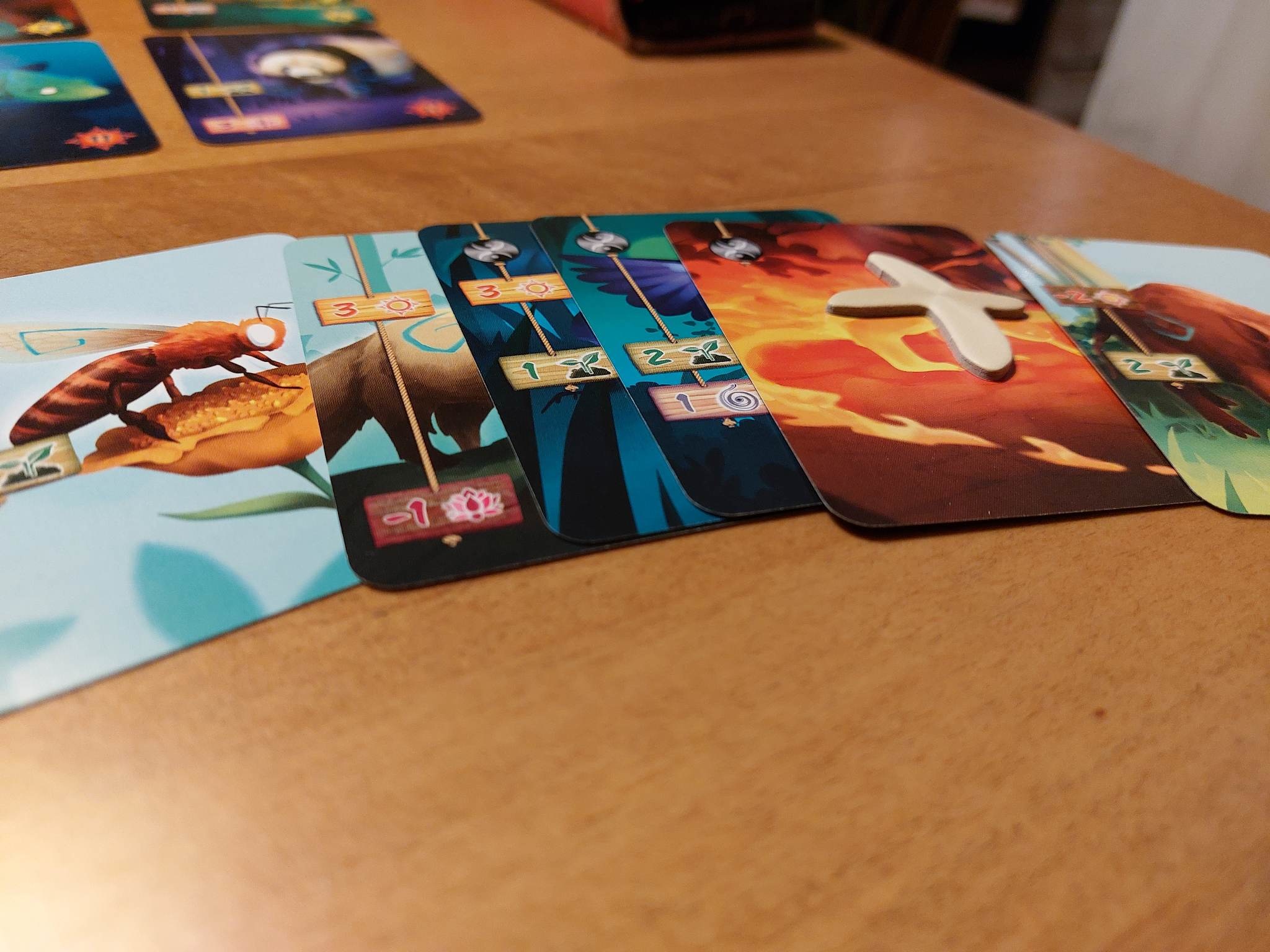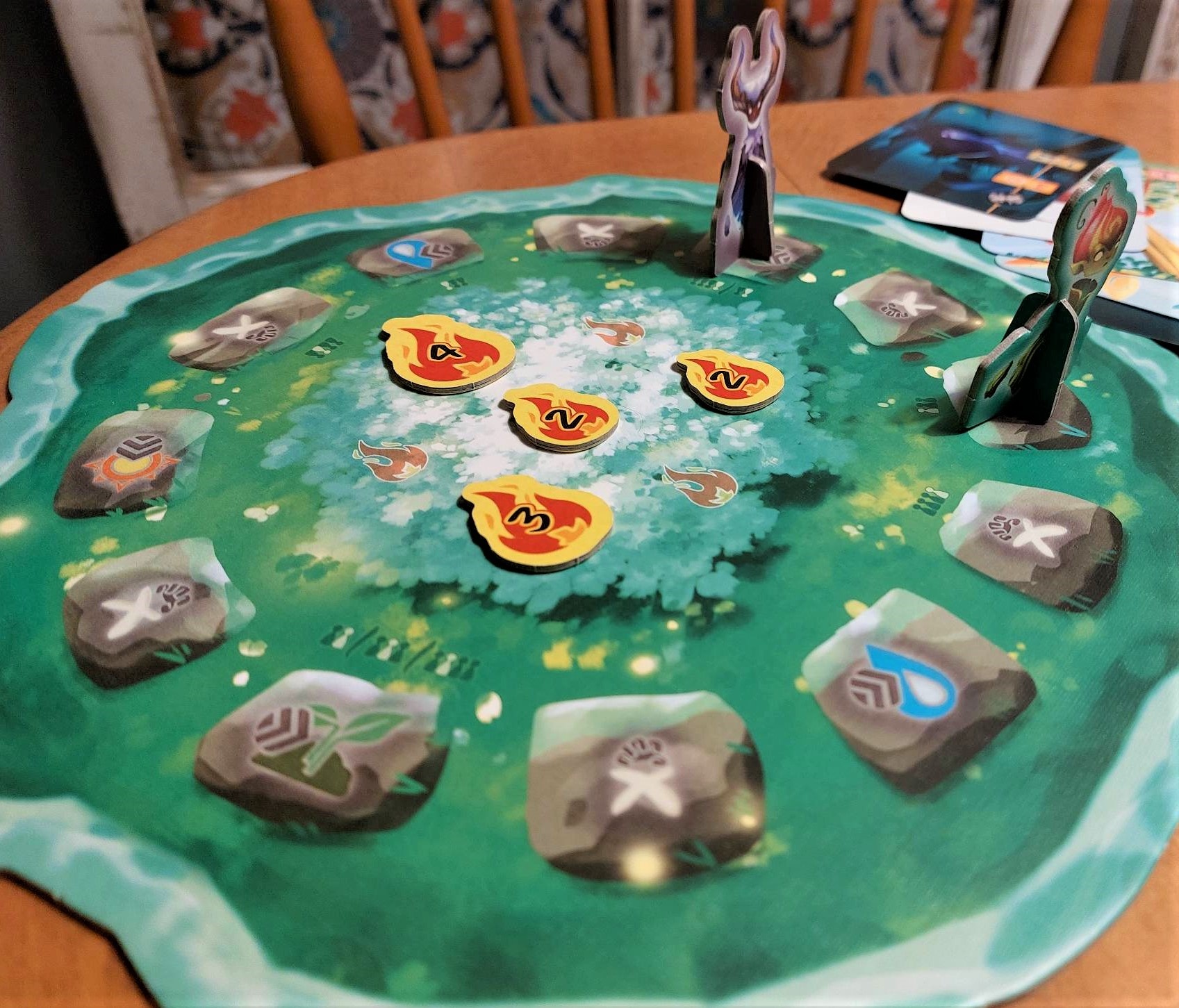Living Forest: A Game of Mind(s)
We want to exculpate ourselves from the outset of the sad joke here, which is not really quite one, moreover: Tsé that removing "Living", we would still have the same title, huh? Because a forest is alive, like… Heh. Pardon. You were warned. That said, it's still not wrong – we would essentially keep the same title without the first word. But we understand, however, that the title Spirits of the Forest is already taken by another game, which is a shame, because it would apply very well here… But we are beating around the bush, there!
Ahem.
GOOD!
As autumn draws to a close, a few snowflakes have already appeared on the tip of our noses, and the chilly evenings are more likely to see us snuggled up indoors, lovingly stroking a big mug of hot chocolate, why not not go back to the green forest (not the youth show of yore, there)?
This is exactly what the Living Forest game, from Ludonaute editions, offers us. Put on your walking boots, we're going into the woods!
The heart
Living Forest is a game combining the mechanics of "deck-building", "set collection" and "push your luck". These mechanics are put in place for the premise of the game, which is to protect the sacred tree from the flames of Onibi, the fiery spirit, who acts as an antagonist to the players and tries to burn down the tree in question. Onibi's motives? No kind of idea. The instruction booklet only mentions the need to counter it at all costs. (If we were forced to identify the source of Onibi's anger anyway, we would argue that Sanki, the guardian spirit of the forest, once borrowed a cup of sugar from Onibi and never gave it back. Worse yet , Sanki is now sleeping!)
Well, we invent stuff, but still, Sanki is really sleeping, as will be explained below...
The four players (from 2 to 4, in fact) therefore embody the brave spirits of the 4 seasons who must do everything they can, roots and branches, in order to prevent Onibi from reducing the sacred tree to ashes. To do this, they will get the help of guardian animals, protective trees, and maybe Sanki, if they manage to wake him up! Whoever manages to repel Onibi will become the new great guardian spirit of the forest!
The style
The visuals are absolutely stunning. The guardian animal cards are all splendidly illustrated, and all the pieces of the game benefit from the same treatment: very zen, relatively refined, but which really gives a "lush forest" aspect to the smallest piece of cardboard. The artist, Apolline Etienne, has really pulled off a tour de force as far as we are concerned.
The cardboard pieces are of good quality, no plastic to break the tactile side, either (bravo, huh, because choooouuuuuu the plastic). The two supports for the protective shafts are well made and even after several games and several manipulations, do not seem to want to come undone prematurely.

Our only downside is that the base of the figures, the result of two intersecting pieces of cardboard, and a little thinner on two of the four sides - as a result of which the standees (figurines, generally made of cardboard, with or without base plastic) tend to fall to the side. Yes, we know, yes, it's not the sea to drink, nor the forest to cut down, but still, we found ourselves on several occasions raising our seasonal spirits...
The course of the game
Each turn is made up of the same three phases throughout the game, namely: the guardian phase, the action phase, and the end of turn phase.
Guardians phase
Each player has a deck of guardian animal cards. At the start of the game, these decks are identical, but from the first turn, there is a very good chance that one or more players will fill their personal deck with new guardian animals. These animals come in three types: "normal", solitary, and gregarious...

Simultaneously, players flip guardian cards over until they decide to quit or have revealed three lone animal symbols. These animals don't like company too much, and a third added to your line of guardians will end your draw turn. That said, it is possible that you also have gregarious animals in your hand, which cancel out a solitary animal symbol – thus making it possible to have up to three (or more) solitary animal symbols. before having to stop. The more gregarious you have, the more loners you can handle – gregarious are great extroverts and favor the company of others. It's all in the balance!
If you stay below the solitary limit, you can perform two actions in the next phase. If we exceed this limit, we will be limited to one.
The problem? Solitary animals are also VERY profitable in terms of points needed to do actions, so we are always tempted to go a little further, just in case… This is the push your luck aspect we were talking about at the beginning. On the other hand, gregarious animals are not very profitable, and sometimes even take away points… So you have to balance all that!
The five animal symbols are: Sun, Water Drop, Tree, Spiral and Flower.
Action phase
Once the guardian phase is over, there are four possible main actions, each with its different symbol found on the guardian cards. These actions are: planting a protective tree (tree), extinguishing Onibi's fires (drop of water), advancing on the circle of spirits (spiral), and recruiting a guardian animal (sun). The value of each action and the number of actions you can perform will vary depending on the outcome of the previous phase. You add up all the symbols of the same kind, and you perform one or two actions, depending on whether or not you have exceeded the limit of solitary animals.
When we plant a protective tree, we simply take a tree of equal or lesser value to the number of trees present in the line of guardians and on the rest of our game elements (there may be some on trees already purchased, Besides). Then, we flatten this tree on our personal tray. Each column, each row and each corner of the board grants a bonus to whoever fills them.
The extinguished action of the lights
As its name suggests, the action of extinguishing fires makes it possible to fight against Onibi's efforts and thus protect the Sacred Tree. When we want to extinguish a fire, we calculate the number of drops of water revealed on our animals and our game elements, then we extinguish fires whose combined value (it varies between 2, 3 and 4 per fire) does not exceed not that of the drops. Simple!
It is also an action that prevents Onibi from polluting your deck with his fire monitors. Indeed, once all the players have performed their actions, we must check the total value of the fires remaining in the circle of spirits and compare it to the water value of all the players. If a player has a lower water value than the fires, monitor lizards come and wreak havoc on their draw pile (these offer no benefit and have a solitaire symbol).
Advance on the circle of spirits
Advancing on the circle of spirits involves risks and advantages that are less obvious to grasp… When we advance on the circle, we can perform the action inscribed on the stone or our spirit stops. So it's kind of a bonus action, if you will. In addition, if we go over the spirit of another player, we take a spirit token of our choice (tree, flower, fire). These tokens bring us closer to victory, since each of them counts in their respective category!

Another action is offered to the players: that of obtaining an X, if ever none of the other actions is favorable or possible.
End of turn
At the end of each round, it is checked whether a player or players have met one or more victory criteria. If so, the winner is determined and he goes off to celebrate, while the others have to clean up the undergrowth (still, so many animals and fire, it's a mess…).
If no one has won yet, we calculate the fires, we fill the market animals, we pass the first player token to the left and we play a full turn again!
Game over
The end of the game is triggered when a player has met one of the criteria to win the game (yes yes, duuuuuuuuhhhh… ). Moreover, since we are there, here is how we win the game of Living Forest: it is enough to have, at the end of a turn, extinguished a total of 12 fires, or planted 12 different protective trees, or to have accumulated, on the line of guardians, 12 magic flowers used to wake up Sanki. That's all! But since nothing is secret in this game, the other players can at any time try to pass us on the circle to slow us down in our race towards victory… Like what, there's no fire (yet)!
In short, if we manage to obtain and keep the 12 fires/flowers/trees, we win, and our spirit becomes the new Great Protective Spirit (yes, because Sanki, as they say, sleeps on a switch)!
The verdict
Living Forest is a charming game, really not too complex, and frankly easy to pick up. We believe the suggested 10+ on the box is a conservative estimate, and many families will see their younger children learning and enjoying the game. token theft caused by the circle of spirits, but even that can be circumvented: we tested a different mechanic, of our own, where you just overtake, without stealing anything, and the pleasure of having a bonus action is enough to make the circle of spirits relevant regardless. We can also decree that by overtaking another player, we draw the first level 1 animal card to add it to our personal deck. In short: many ways to remove that “take that!” element. » a bit more aggressive…
With the game moving quickly, even simultaneously at times, Living Forest never overpowers itself, making it an excellent choice for Saturday or Sunday morning, or early evening.
We could replace with something general like: are tired of playing fast and noisy games.
We're not judging anyone here. Promised!
- Biz and Mooh




Leave a comment